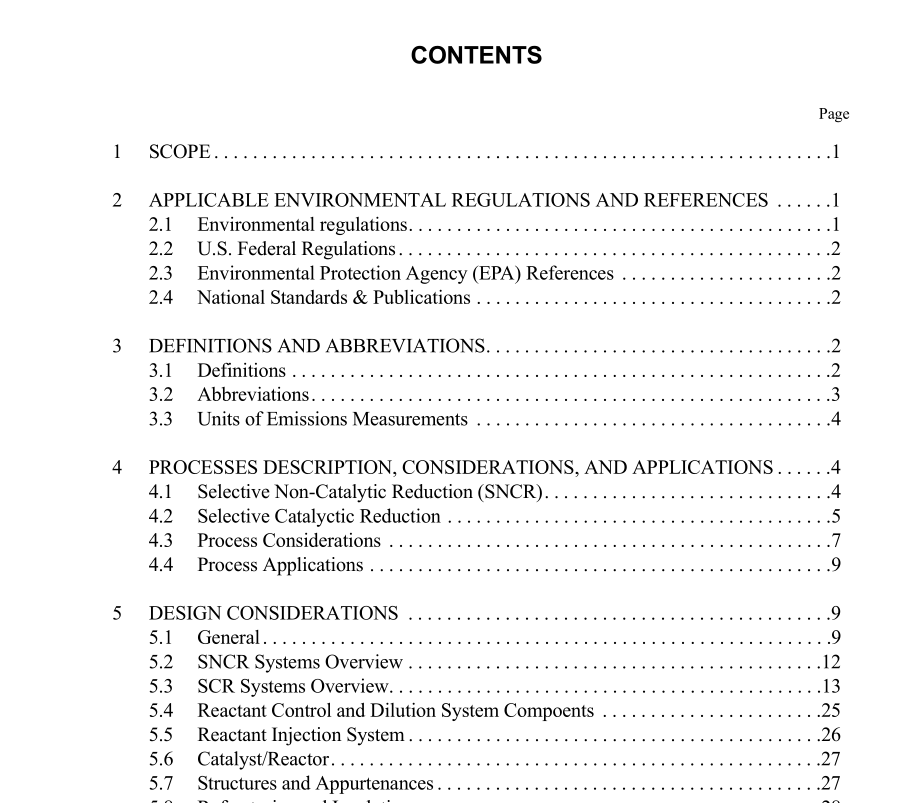API RP 536 pdf download

API RP 536 pdf download.Post-Combustion NO x Control for Fired Equipment in General Refinery Services
1 Scope
1.1 This recommended practice covers the mechanical description, operation, maintenance, and test procedures of post-com- bustion NO x control equipment for fired equipment in general refinery service. It does not cover reduced NO x formation through combustion design techniques, such as flue gas recirculation (FGR) and staged combustion. 1.2 This document covers two of the methods of post combustion NO x reduction: a. Selective Non-Catalytic Reduction (SNCR). b. Selective Catalytic Reduction (SCR). 1.3 SNCR is a process where the addition of ammonia or urea into the flue gas stream causes the oxides of nitrogen to convert to nitrogen and water vapor. The basis for the selection and limitations of the SNCR systems are described in 4.1. 1.4 SCR is a process where the addition of ammonia into the flue gas stream in the presence of a suitable catalyst causes the oxides of nitrogen to convert to nitrogen and water vapor. The basis for the selection of the various catalyst types are described in 4.2. 1.5 Table 1 indicates the typical operating performance and limitations of both types of NO x reduction systems. The reduction efficiency of SNCR is limited because of the flue gas temperature range and difficulty in achieving proper mixing of the reactants, but is often suitable for retrofitting existing equipment for low or moderate NO x reduction. SCR systems operate at high reduction efficiency at a lower temperature window than an SNCR system and are usually selected for lowest NO x emission.
3 Definitions and Abbreviations
3.1 DEFINITIONS 3.1.1 ammonia breakthrough: The point at which increasing the NH 3 /NO x molar ratio does not significantly reduce the amount of NO x . 3.1.2 ammonia/NO x ratio: The molar ratio of injected ammonia to the inlet NO x in the flue gas stream. 3.1.3 ammonia slip: The amount of unreacted ammonia in the flue gas stream after the reduction of the NO x , measured in ppmvd corrected to the standard oxygen level. 3.1.4 ammonium bisulfate and ammonium sulfate: Compounds formed when ammonia or urea injected into a flue gas stream combine with sulfur trioxide. These compounds may foul heat transfer surface and increase particulate emissions. 3.1.5 catalyst activity: Measurement of the NO x reduction performance. 3.1.6 catalyst handling facilities: Device used for loading and unloading of catalyst modules, usually a monorail and hoist. 3.1.7 catalyst matrix or substrate: Substance that is coated or impregnated by the active ingredients of the catalyst. The catalyst matrix can be made from ceramic honeycomb, pellets, metal plates or mesh. 3.1.8 catalyst module: Catalyst elements that are shop assembled for installation into an SCR catalyst housing. Module con- sists of a steel frame with suitable lifting lugs for installation and removal of the modules into SCR catalyst housing. A catalyst layer consists of catalyst modules that cover the entire cross-section flow area. 3.1.9 catalyst poisoning: Degradation of NO x reduction activity when flue gas component is adsorbed on the active sur- faces of the catalyst and renders it inactive. 3.1.10 catalyst space velocity: The quantity of flue gas (at standard conditions) flowing per volume of catalyst per hour. 3.1.11 catalyst support: Structure within the reactor housing to support the catalyst modules. 3.1.12 catalyst type: Category of catalyst denoted by the active ingredient, namely vanadium oxide, titanium oxide, plati- num, or zeolite.3.1.13 cell density: Measurement of hole density in a honeycomb catalyst matrix (cells per sq. cm [sq. in.]). 3.1.14 dilution medium: Fluid (usually air, steam, or water) used to disperse the reactant within the flue gas stream—also referred to as a “carrier.” 3.1.15 injection grid: a series of distribution pipes and injection nozzles located in the flue gas stream to enable effective mixing of the reactant and flue gas. 3.1.16 masking: Condition when the outer surfaces of the catalyst are covered with foreign material rendering the inner active surfaces inaccessible for NO x reduction. 3.1.17 NO x : General term used to describe all oxides of nitrogen including nitric oxide (NO), nitrogen dioxide (NO 2 ), and nitrous oxide (N 2 O). For the purpose of emission calculations, NO x is assumed to be nitrogen dioxide MW = 46.01. 3.1.18 reactant ammonia: Anhydrous or aqueous ammonia used in the majority of post combustion NO x reduction systems. Industrial anhydrous ammonia contains 99.5% minimum by volume ammonia and is injected as a vapor. Aqueous contains about 19% – 29% by weight ammonia solution mixed with water and has to be vaporized or atomized before injecting into the gas stream. 3.1.19 reactant flow control unit: Contains the equipment and instrumentation necessary for control and injection of the reactant (ammonia or urea), including but not limited to vaporizer or atomizer, dilution air fan, mixer, and control valves. 3.1.20 reactant urea: Used in some SNCR processes. Urea is normally used as an aqueous solution containing about 50% urea by weight.









